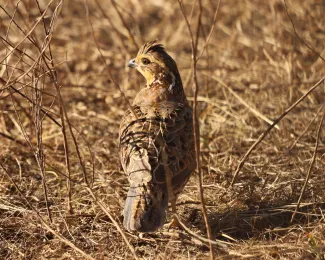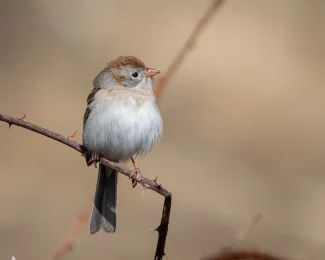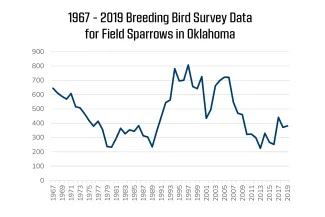Across North America, most birds have been steadily declining since 1970, according to a study in Science from 2019. This downward trend is generally attributed to widespread habitat loss. Specifically, increased fragmentation of habitat tracts, conversion from native plant communities to cropland or introduced pasture (like bermudagrass, Old World bluestem, fescue, and other introduced monoculture species), use of pesticides and herbicides, and degraded plant community structure all contribute greatly to the reduction in native habitat quality and availability across many biomes.
Situated squarely within the Central Flyway, Oklahoma has two major biomes which should provide breeding and wintering grounds for resident and migrant bird species - prairie (tallgrass, mixed-grass) and eastern deciduous forest (cross timbers, oak-hickory transitional forest).
According to the 2019 study, birds that rely on grassland/shrubland habitats have experienced the greatest population decline – 720 million fewer birds since 1970.
Ground-nesting songbird species, much like northern bobwhite and other ground-nesting game bird species, within grasslands have been hit particularly hard. Ideal ground nesting habitats vary across species, but are always native plant communities of grasslands, shrublands, edges, or woodlands where canopy cover is less than 50%.

The field sparrow, a species that has experienced a 69% range-wide population decline from 1966 to 2015, according to the North American Breeding Bird Survey, has seen downward population trends in Oklahoma, and is among these songbird species of concern.
Although a migratory species, field sparrows can and do spend a majority of the year in Oklahoma, requiring both breeding and wintering habitat. In the spring, this small bird may be easier heard than seen. Their distinct, quickening “bouncing-ball” song tends to stand out in any chorus.
These birds prefer open scrub and shrub habitats with plenty of low perches. Their main source of food year-round are hardy seeds from tallgrasses and from forbs like ragweed and sunflowers, but in the summer, field sparrows use the low perches to pounce on a variety of insects, incorporating insects as about half of their diet during this time. They breed in recently burned fields where perches are still available and will avoid sites that are too overgrown with shrubs or trees.

Field sparrows occur in Oklahoma year-round, but are experiencing declines according to the Breeding Bird Survey.

Using only this species as an example, as acres are degraded due to severe brush encroachment or are converted and native herbaceous broadleaf plants sprayed, there becomes even less potential habitat for this already steeply declining bird.
Fragmentation becomes another range-wide issue for so many of these songbirds. In Oklahoma, we experience fragmentation where once large farms or ranches are broken up and sold as smaller tracts. An original 2,000-acre property might now be sold as multiple 80-acre or smaller tracts.
While maintaining any quality or quantity of contiguous wildlife habitat intact in this example may be more difficult or complex, this example of fragmentation is not inherently bad. In this case, if the majority of the new landowners have primary or secondary wildlife objectives for their properties, collectively, they have the potential to increase the availability of quality habitat for songbirds and other wildlife species. It’s all in how it’s managed.
No matter the size of the property, it is generally best to focus on managing the native plant community and structure based on soil type, geographic location, and climate.
Knowing what your property should look like, which native plants should be occurring and in what arrangement is critical for any land manager to know, especially when managing for wildlife.
Conducting prescribed burns that control brush encroachment or increase native forb production, minimizing or foregoing unnecessary broadcast herbicide applications by selectively spraying target invasive plant species, and restoring converted lands back to native, will all aid in increasing quality available habitat that will benefit resident and migrant songbirds.